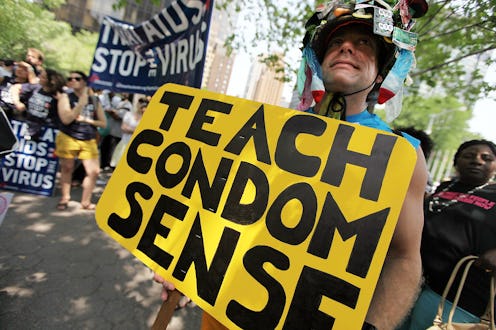News
The Problem With Sex Ed
Looking back on it, my sex education classes crack me up. I mean, come on: Who didn't love those once-weekly lectures full of awkward questions, scarring pictures of warts where warts are not meant to grow, and giggle-filled moments of trying to roll on a condom over a banana? Maybe we dreaded them at the time, but they sure make for comedy gold now. Teaching us what our bits and pieces were actually for before we got into situations in which we'd actually be using them? An added bonus! In case this upshot was not obvious to you, a new study confirms that giving sex ed classes to kids before they hit puberty is imperative for teaching them lasting lessons about sexual health.
The study, which was conducted by Georgetown University and published in Global Public Health, found that attendance of sex ed classes between the ages of 10 and 14 is good for "positive youth development to promote sexual and reproductive health (SRH)... [and] is imperative to lay foundations for healthy future relationships and positive SRH." In other words, teach kids about their bodies before they can have sex — duh. Otherwise, if they don't know what STDs are out there, or what their symptoms are, or how they work, how are adolescents going to keep themselves from getting a nasty case of gonorrhea or HPV? What's more, how are they going to know the difference between the pill, an IUD, and a diaphragm?
Remember how Cady and her friends were getting sex ed classes in high school? They probably should have gotten the safe sex talk years before that. According to the study, the ages of 10 to 14 are when many kids start exploring their own sexuality and engaging in sexual behaviors.
This study comes at a point when less than 46 percent of males and 33 percent of females in the U.S. receive formal instruction on contraception methods before their first time having sex. Forty-one percent of teens 18 to 19 say that they know "little to nothing" about condom use, which is more than a little terrifying. In addition, the sex ed classes that do exist are often filled with inaccurate or threatening information. Mississippi teachers must inform students that homosexual acts are illegal, for one, and a California middle school made the mistake of trying to get students to admit how far they would go in sexual situations. Are either of those instances conducive to healthy attitudes toward sexuality? Probably not.
...and this is why we need sex ed, people.
There are also certain groups that are far more likely to need good sex ed, and one of the biggest is LGBTQ teens. A survey in the Canadian province of British Columbia has shown that gay, lesbian, and bisexual adolescents are twice as likely to either cause a pregnancy or become pregnant. Although that may seem contrary to popular thought, think about it for a moment: Having heterosexual sex would be considered heteronormative behavior. It can make a gay or lesbian teen who might be unwilling or unable to embrace his/her sexuality seem like "one of the guys" or "one of the girls."
Claire O'Gorman, a Canadian sex educator, called for a sex ed curriculum that is more inclusive of homosexuality and bisexuality. "People who are part of queer communities need to have their voices at the table to discuss what the curriculum should look like, so it's as inclusive and relevant as possible," she said.
All of this makes me incredibly grateful for my own sex education experience, in which the teacher put on Salt-n-Pepa's "Let's Talk About Sex" and we had a dance party while pretending to be sperm. Take note, sex ed curriculum writers: all classes should include a) accurate information about birth control and STDs; b) facts for LGBTQ students; and c) a sperm dance party.
Images: Popsugar; Imogen Poots RPH, GIF Awesomeness/Tumblr
